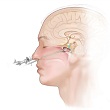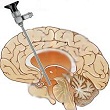The endoscopic techniques performed by Neurosurgery at our
National Center for Minimally Invasive Surgery are since 2010. The neurosurgeons that accomplish neurosurgical
approaches both endoscopic transcranial and transnasal for the past six years have been qualified by the Cuban
School of Neurosurgery and endorsed by courses and training at several worldwide high level centers such as:
Wexner Medical Center and The James, Columbus, Ohio, United States; Prince of Wales Private Hospital, Sidney,
Australia; Hospital G. Rummo” Benevento, Naples, Italy; Hospital Regional de Málaga, Spain; Hospital Vall de
Hebrón, Barcelona, Spain. Children Hospital, Ottawa, Canada; Children Hospital, Vancouver, British, Columbia,
Canada; Hospital Gemelli, Rome, Italy; Hospital Británico de Montevideo, Uruguay; Hospital Civil Nuevo de
Guadalajara, Mexico, among others.
In the past six years, we have performed 544 endoscopic cranial base approaches, becoming pioneers in the
introduction of guided Neuronavigation of cranial base in Cuba.
The neurosurgical team at the NCMIS has a vast experience in performing neuroendoscopic transcranial
techniques in over 300 patients in the past 12 years.
Pituitary Tumor Resections | CSF Fistula Repair | Hydrocephalus

Our hospital is a pioneer in Cuba in applying Neuronavigation in skull base endoscopic surgery.
Neurosurgery uses two main types of minimally invasive neuroendoscopic techniques.
Transnasal endoscopic approaches: It is used in skull base diseases. The two most frequent lesions approached in our country are skull base tumors in the anterior, medial and posterior cranial fossa, as well as the cerebrospinal fluid (CSF) fistulas that affect this anatomic region. The following neuroendoscopic techniques are applied.
Standard Transnasal Approach: It is mainly applied in the treatment of skull base tumors, such as pituitary adenoma, intrasellar arachnoidoceles, Rathke's pouch cyst and cerebrospinal fluid nasal fistulas.
Extended Transnasal Approach: It is used in tumor lesions that are extended beyond the sellar region limits and invade or are located in other cranial fossae. It is a complex technique used to treat tumor lesions, such as tuberculum sellae meningiomas, craniopharyngiomas, hypothalamic gliomas, cholesteatomas and chordomas of the skull base. Also in invasive pituitary adenomas.
In the past three years, our neurosurgery team has performed 314 cranial base approaches related to these diseases since the beginning of this kind of surgery at the NCMIS on March 2010.
Physician Team:
Luis Alonso Fernández, MD, PhD
Tania Leyva Mastrapa, MD, PhD
Adolfo Hidalgo González, MD
Oreste González Torres, MD
Contact: tursalud@cce.sld.cu

It is performed by using a neuroendoscope through a small cranial trephine orifice of 2-cm diameter with access to the ventricular system and to the encephalon deep structures. It is used for the treatment of diseases like obstructive Hydrocephalus, arachnoid cysts and intra- and para-ventricular tumors. The following neuroendoscopic techniques are applied:
a) Endoscopic ventricucisternostomy of the 3rd encephalic ventricle.
b) Septostomy.
c) Monroplasty.
d) Aqueductoplasty.
e) Choroid plexus coagulantion.
f) Fenestration, marzupialization and exeresis of intracranial cysts, such as
craniopharyngiomas, III-ventricle colloidal cysts, arachnoid cysts, cavun vergae and cavun septum
pellucidum cysts.
g) Biopsy, partial and total exeresis of intraventricular and paraventricular
intracranial tumors.
h) Endoscopic positioning of intracranial cysts catheters connected to epicranial
reservoirs for evacuation and use in antitumoral brachytherapy.
The neurosurgical team at the NCMIS has a 10-year experience in performing intracranial neuroendoscopic techniques on over 250 patients.
Physician Team:
Luis Alonso Fernández, MD, PhD
Tania Leyva Mastrapa, MD, PhD
Adolfo Hidalgo González, MD
Oreste González Torres, MD
Contact: tursalud@cce.sld.cu